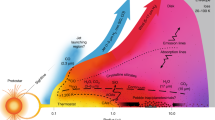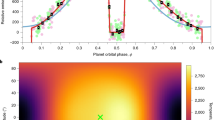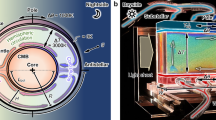Abstract
Lava planets are rocky exoplanets that orbit so close to their host star that their dayside is hot enough to melt silicate rock. Their short orbital periods ensure that lava planets are tidally locked into synchronous rotation, with permanent day and night hemispheres. Such asymmetric magma oceans have no analogues in the Solar System and their internal dynamics and evolution are still poorly understood. Here we report the results of numerical simulations showing that solid–liquid fractionation has a major impact on the composition and evolution of lava planets. We explored two different interior thermal states. If the interior is fully molten, the atmosphere will reflect the planet’s bulk silicate composition, and the nightside solid surface is gravitationally unstable and constantly replenished. If the interior is mostly solid with only a shallow magma ocean on the dayside, the outgassed atmosphere will lack in Na, K and FeO, and the nightside will have an entirely solid mantle with a cold surface. We show that these two end-member cases can be distinguished with observations from JWST, offering an avenue to probe the thermal and chemical evolution of exoplanet interiors.
This is a preview of subscription content, access via your institution
Access options
Access Nature and 54 other Nature Portfolio journals
Get Nature+, our best-value online-access subscription
$32.99 / 30 days
cancel any time
Subscribe to this journal
Receive 12 digital issues and online access to articles
$119.00 per year
only $9.92 per issue
Buy this article
- Purchase on SpringerLink
- Instant access to full article PDF
Prices may be subject to local taxes which are calculated during checkout






Similar content being viewed by others
Data availability
All data used in this paper are accessible via the fair depository of the Institut de Physique du Globe de Paris at https://doi.org/10.18715/IPGP.2024.m41y3glp (ref. 85).
Code availability
The code MagIc72,73,74 is open source and can be accessed at https://magic-sph.github.io/. MagIc version 6.0 was used and is also available via Zenodo at https://doi.org/10.5281/zenodo.595153 (ref. 86). The code Bambari can be accessed on GitHub upon reasonable request.
References
Léger, A. et al. Transiting exoplanets from the CoRoT space mission: VIII. CoRoT-7b: the first super-Earth with measured radius. Astron. Astrophys. 506, 287–302 (2009).
Espinoza, N. et al. The first near-infrared spectroscopic phase-curve of a super-Earth. JWST Proposal Cycle 1 2159 (2021).
Driscoll, P. E. & Barnes, R. Tidal heating of earth-like exoplanets around M stars: thermal, magnetic, and orbital evolutions. Astrobiology 15, 739–760 (2015).
Valencia, D., Ikoma, M., Guillot, T. & Nettelmann, N. Composition and fate of short-period super-Earths—the case of CoRoT-7b. Astron. Astrophys. 516, A20 (2010).
Owen, J. E. Atmospheric escape and the evolution of close-in exoplanets. Annu. Rev. Earth Planet. Sci. 47, 67–90 (2019).
Schaefer, L. & Fegley, B. Jr Outgassing of ordinary chondritic material and some of its implications for the chemistry of asteroids, planets, and satellites. Icarus 186, 462–483 (2007).
Castan, T. & Menou, K. Atmospheres of hot super-Earths. Astrophys. J. Lett. 743, L36 (2011).
Kite, E. S., Fegley, B. Jr, Schaefer, L. & Gaidos, E. Atmosphere-interior exchange on hot, rocky exoplanets. Astrophys. J. 828, 80 (2016).
Ito, Y. et al. Theoretical emission spectra of atmospheres of hot rocky super-Earths. Astrophys. J. 801, 144 (2015).
Nguyen, T. G., Cowan, N. B., Pierrehumbert, R. T., Lupu, R. E. & Moores, J. E. The impact of ultraviolet heating and cooling on the dynamics and observability of lava planet atmospheres. Mon. Not. R. Astron. Soc. 513, 6125–6133 (2022).
Zilinskas, M. et al. Observability of evaporating lava worlds. Astron. Astrophys. 661, A126 (2022).
Schaefer, L. & Fegley, B. Chemistry of silicate atmospheres of evaporating super-earths. Astrophys. J. 703, L113 (2009).
Meier, T. G., Bower, D. J., Lichtenberg, T., Hammond, M. & Tackley, P. J. Interior dynamics of super-Earth 55 Cancri e. Astron. Astrophys. 678, A29 (2023).
Nguyen, T. G., Cowan, N. B., Banerjee, A. & Moores, J. E. Modelling the atmosphere of lava planet K2-141b: implications for low-and high-resolution spectroscopy. Mon. Not. R. Astron. Soc. 499, 4605–4612 (2020).
Lammer, H. et al. Origin and loss of nebula-captured hydrogen envelopes from ‘sub’-to ‘super-Earths’ in the habitable zone of Sun-like stars. Mon. Not. R. Astron. Soc. 439, 3225–3238 (2014).
Lai, Y., Yang, J. & Kang, W. Ocean circulation on tide-locked lava worlds. I. An idealized 2D numerical model. Planet. Sci. J. 5, 204 (2024).
Lai, Y., Kang, W. & Yang, J. Ocean circulation on tide-locked lava worlds. II. Scalings. Planet. Sci. J. 5, 205 (2024).
Miguel, Y., Kaltenegger, L., Fegley, B. & Schaefer, L. Compositions of hot super-earth atmospheres: exploring Kepler candidates. Astrophys. J. Lett. 742, L19 (2011).
Chao, K.-H. et al. Lava worlds: from early earth to exoplanets. Geochemistry 81, 125735 (2021).
Rizo, H., Boyet, M., Blichert-Toft, J. & Rosing, M. T. Early mantle dynamics inferred from 142Nd variations in archean rocks from southwest Greenland. Earth Planet. Sci. Lett. 377-378, 324–335 (2013).
Blichert-Toft, J., Gleason, J. D., Télouk, P. & Albarède, F. The Lu–Hf isotope geochemistry of shergottites and the evolution of the Martian mantle–crust system. Earth Planet. Sci. Lett. 173, 25–39 (1999).
Bouvier, L. C. et al. Evidence for extremely rapid magma ocean crystallization and crust formation on Mars. Nature 558, 586–589 (2018).
Barragán, O. et al. K2-141 b. A 5-M⊕ super-Earth transiting a K7 V star every 6.7 h. Astron. Astrophys. 612, A95 (2018).
Curry, A., Booth, R., Owen, J. E. & Mohanty, S. The evolution of catastrophically evaporating rocky planets. Mon. Not. R. Astron. Soc. 528, 4314–4336 (2024).
Jura, M. & Young, E. Extrasolar cosmochemistry. Annu. Rev. Earth Planet. Sci. 42, 45–67 (2014).
Fiquet, G. et al. Melting of peridotite to 140 gigapascals. Science 329, 1516–1518 (2010).
Hughes, G. O. & Griffiths, R. W. Horizontal convection. Annu. Rev. Fluid Mech. 40, 185–208 (2008).
Lebrun, T. et al. Thermal evolution of an early magma ocean in interaction with the atmosphere. J. Geophys. Res. Planets 118, 1155–1176 (2013).
Maas, C. & Hansen, U. Dynamics of a terrestrial magma ocean under planetary rotation: a study in spherical geometry. Earth Planet. Sci. Lett. 513, 81–94 (2019).
Zhang, K. & Gubbins, D. On convection in the Earth’s core driven by lateral temperature variations in the lower mantle. Geophys. J. Int. 108, 247–255 (1992).
Dietrich, W., Hori, K. & Wicht, J. Core flows and heat transfer induced by inhomogeneous cooling with sub-and supercritical convection. Phys. Earth Planet. Inter. 251, 36–51 (2016).
Showman, A. P. & Polvani, L. M. Equatorial superrotation on tidally locked exoplanets. Astrophys. J. 738, 71 (2011).
Lejeune, A.-M. & Richet, P. Rheology of crystal-bearing silicate melts: an experimental study at high viscosities. J. Geophys. Res. 100, 4215–4229 (1995).
Herath, M., Boukaré, C.-É. & Cowan, N. B. Thermal evolution of lava planets. Mon. Not. R. Astron. Soc. 535, 2404–2414 (2024).
Nomura, R. et al. Spin crossover and iron-rich silicate melt in the Earth’s deep mantle. Nature 473, 199–202 (2011).
Boukaré, C.-É., Cowan, N. B. & Badro, J. Deep two-phase, hemispherical magma oceans on lava planets. Astrophys. J. 936, 148 (2022).
Labrosse, S., Hernlund, J. & Coltice, N. A crystallizing dense magma ocean at the base of the Earth’s mantle. Nature 450, 866–869 (2007).
Samuel, H. et al. The thermo-chemical evolution of mars with a strongly stratified mantle. J. Geophys. Res. Planets 126, e2020JE006613 (2021).
O’Rourke, J. G. Venus: a thick basal magma ocean may exist today. Geophys. Res. Lett. 47, e2019GL086126 (2020).
Hu, R. et al. Determining the atmospheric composition of the super-Earth 55 Cancri e. JWST Proposal. Cycle 1 1952 (2021).
Brandeker, A. et al. Is it raining lava in the evening on 55 Cancri-e? JWST Proposal Cycle 1 2084 (2021).
Dang, L. et al. A hell of a phase curve: mapping the surface and atmosphere of a lava planet K2-141b. JWST Proposal Cycle 1 2347 (2021).
Hammond, M. & Pierrehumbert, R. T. Linking the climate and thermal phase curve of 55 Cancri e. Astrophys. J. 849, 152 (2017).
Ito, Y. & Ikoma, M. Hydrodynamic escape of mineral atmosphere from hot rocky exoplanet. I. Model description. Mon. Not. R. Astron. Soc. 502, 750–771 (2021).
Piette, A. A. A. et al. Rocky planet or water world? Observability of low-density lava world atmospheres. Astrophys. J. 954, 29 (2023).
Mcdonough, W. & Sun, S. The composition of the Earth. Chem. Geol. 120, 223–253 (1995).
Wolf, A. S., Jäggi, N., Sossi, P. A. & Bower, D. J. VapoRock: thermodynamics of vaporized silicate melts for modeling volcanic outgassing and magma ocean atmospheres. Astrophys. J. 947, 64 (2023).
van Buchem, C., Miguel, Y., Zilinskas, M. & van Westrenen, W. LavAtmos: gas–melt equilibrium calculations for a given temperature and melt composition. Meteorit. Planet. Sci. 58, 1149–1161 (2023).
Charnoz, S. et al. The effect of a small amount of hydrogen in the atmosphere of ultrahot magma-ocean planets: atmospheric composition and escape. Astron. Astrophys. 674, A224 (2023).
Tremblin, P. et al. Cloudless atmospheres for L/T dwarfs and extrasolar giant planets. Astrophys. J. 817, L19 (2016).
Feinstein, A. D. et al. Early Release Science of the exoplanet WASP-39b with JWST NIRISS. Nature 614, 670–675 (2023).
Lustig-Yaeger, J., Meadows, V. S. & Lincowski, A. P. The detectability and characterization of the TRAPPIST-1 exoplanet atmospheres with JWST. Astron. J. 158, 27 (2019).
Ehrenreich, D. et al. A giant comet-like cloud of hydrogen escaping the warm Neptune-mass exoplanet GJ 436b. Nature 522, 459–461 (2015).
Kervazo, M., Tobie, G., Choblet, G., Dumoulin, C. & Běhounková, M. Inferring Io’s interior from tidal monitoring. Icarus 373, 114737 (2022).
Boukaré, C.-E. & Ricard, Y. Modeling phase separation and phase change for magma ocean solidification dynamics. Geochem. Geophys. Geosyst. 18, 3385–3404 (2017).
Boukaré, C.-E., Badro, J. & Samuel, H. Solidification of Earth’s mantle led inevitably to a basal magma ocean. Nature 640, 114–119 (2025).
Drew, D. A. Averaged field equations for two-phase media. Stud. Appl. Math. 50, 133–166 (1971).
Mckenzie, D. The generation and compaction of partially molten rock. J. Petrol. 25, 713–765 (1984).
Bercovici, D., Ricard, Y. & Schubert, G. A two-phase model for compaction and damage: 1. General theory. J. Geophys. Res. Solid Earth 106, 8887–8906 (2001).
Keller, T. & Suckale, J. A continuum model of multi-phase reactive transport in igneous systems. Geophys. J. Int. 219, 185–222 (2019).
Šrámek, O., Ricard, Y. & Bercovici, D. Simultaneous melting and compaction in deformable two-phase media. Geophys. J. Int. 168, 964–982 (2007).
Šrámek, O. Modèle d’écoulement biphasé en sciences de la Terre: fusion partielle, compaction et différenciation. PhD thesis, Univ. Lyon - Ecole Normale Supérieure (2007).
Samuel, H. Time-domain parallelization for computational geodynamics. Geochem. Geophys. Geosyst. https://doi.org/10.1029/2011GC003905 (2012).
Samuel, H. A deformable particle-in-cell method for advective transport in geodynamic modelling. Geophys. J. Int. 214, 1744–1773 (2018).
Samuel, H. & Evonuk, M. Modeling advection in geophysical flows with particle level sets. Geochem. Geophys. Geosyst. 11, Q08020 (2010).
Boukaré, C.-E., Ricard, Y. & Fiquet, G. Thermodynamics of the MgO–FeO–SiO2 system up to 140 GPa: application to the crystallization of Earth’s magma ocean. J. Geophys. Res. 120, 6085–6101 (2015).
Karato, S.-i & Wu, P. Rheology of the upper mantle: a synthesis. Science 260, 771–778 (1993).
Solomatov, V. & Moresi, L.-N. Three regimes of mantle convection with non-newtonian viscosity and stagnant lid convection on the terrestrial planets. Geophys. Res. Lett. 24, 1907–1910 (1997).
Wallner, H. & Schmeling, H. Numerical models of mantle lithosphere weakening, erosion and delamination induced by melt extraction and emplacement. Int. J. Earth Sci. 105, 1741–1760 (2016).
Alappat, C. et al. A recursive algebraic coloring technique for hardware-efficient symmetric sparse matrix-vector multiplication. ACM Trans. Parallel Comput. 7, 1–37 (2020).
Bollhöfer, M., Schenk, O., Janalik, R., Hamm, S. & Gullapalli, K. in Parallel Algorithms in Computational Science and Engineering (eds Grama, A. & Sameh, A.) 3–33 (Springer Nature, 2020).
Wicht, J. Inner-core conductivity in numerical dynamo simulations. Phys. Earth Planet. Inter. 132, 281–302 (2002).
Christensen, U. R. et al. A numerical dynamo benchmark. Phys. Earth Planet. Inter. 128, 25–34 (2001).
Schaeffer, N. Efficient spherical harmonic transforms aimed at pseudospectral numerical simulations. Geochem. Geophys. Geosyst. 14, 751–758 (2013).
Gastine, T., Wicht, J. & Aubert, J. Scaling regimes in spherical shell rotating convection. J. Fluid Mech. 808, 690–732 (2016).
Léger, A. et al. The extreme physical properties of the CoRoT-7b super-Earth. Icarus 213, 1–11 (2011).
Gilman, P. A. Nonlinear dynamics of Boussinesq convection in a deep rotating spherical shell-i. Geophys. Astrophys. Fluid Dyn. 8, 93–135 (1977).
Aurnou, J. M., Horn, S. & Julien, K. Connections between nonrotating, slowly rotating, and rapidly rotating turbulent convection transport scalings. Phys. Rev. A 2, 043115 (2020).
Falco, A., Tremblin, P., Charnoz, S., Ridgway, R. J. & Lagage, P.-O. Hydrogenated atmospheres of lava planets: atmospheric structure and emission spectra. Astron. Astrophys. 683, A194 (2024).
Amundsen, D. S. et al. Accuracy tests of radiation schemes used in hot Jupiter global circulation models. Astron. Astrophys. 564, A59 (2014).
Moses, J. I. Chemical kinetics on extrasolar planets. Phil. Trans. R. Soc. A 372, 20130073 (2014).
Batalha, N. E. et al. PandExo: a community tool for transiting exoplanet science with JWST & HST. Publ. Astron. Soc. Pac. 129, 064501 (2017).
Kreidberg, L. batman: basic transit model calculation in Python. Publ. Astron. Soc. Pac. 127, 1161 (2015).
Foreman-Mackey, D., Hogg, D. W., Lang, D. & Goodman, J. emcee: the MCMC hammer. Publ. Astron. Soc. Pac. 125, 306 (2013).
Boukaré, C.-E. et al. The role of interior dynamics and differentiation on the surface and atmosphere of lava planets. IPGP Research Collection https://doi.org/10.18715/IPGP.2024.m41y3glp (2025).
Gastine, T. et al. magic-sph/magic: release MagIC 6.0. Zenodo https://doi.org/10.5281/zenodo.595153 (2021).
Acknowledgements
We thank the organizing committee of the Diversity of Rocky Planets workshop held in Leiden in 2022, where the ideas developed in this project first emerged. This work has received funding from the European Research Council (ERC) under the European Union’s Horizon 2020 research and innovation programme (grant agreement number 101019965- SEPtiM). Parts of this work were supported by the UnivEarthS Labex programme at Université de Paris and IPGP (ANR-10-LABX-0023 and ANR-11-IDEX-0005-02) and Natural Sciences and Engineering Research Council of Canada (RGPIN-2024-06174). Two-dimensional numerical computations were performed on the IPGP S-CAPAD/DANTE platform. D.L. acknowledges the Texas Advanced Computing Center (TACC) at The University of Texas at Austin for providing high performance computing and visualization resources that have contributed to the research results reported within this paper (http://www.tacc.utexas.edu). L.D. acknowledges support from the Banting Postdoctoral Fellowship programme, administered by the Government of Canada and the Trottier Family Foundation.
Author information
Authors and Affiliations
Contributions
C.-E.B. conceived of and designed the analysis, designed the numerical simulations, performed the numerical simulations, produced the figures and wrote the paper. D.L. performed the numerical simulations, produced the figures and analysed the data, and revised the paper. N.B.C. conceived of and designed the analysis, and wrote the paper. H.S. designed the numerical simulations and revised the paper. J.B. conceived of the analysis and revised the paper. L.D. performed the analysis and produced the figures. A.F. performed the analysis and produced the figures. S.C. performed the analysis and revised the paper.
Corresponding author
Ethics declarations
Competing interests
The authors declare no competing interests.
Peer review
Peer review information
Nature Astronomy thanks Christy Till and the other, anonymous, reviewer(s) for their contribution to the peer review of this work.
Additional information
Publisher’s note Springer Nature remains neutral with regard to jurisdictional claims in published maps and institutional affiliations.
Supplementary information
Supplementary Information
Supplementary information providing detailed modelling parameters, supporting analytical calculations and fluid dynamics simulations. The documents contain 10 supplementary figures.
Supplementary Video 1
Time evolution of the temperature field corresponding to Fig. 3.
Supplementary Video 2
Time evolution of the compositional field corresponding to Fig. 3.
Rights and permissions
Springer Nature or its licensor (e.g. a society or other partner) holds exclusive rights to this article under a publishing agreement with the author(s) or other rightsholder(s); author self-archiving of the accepted manuscript version of this article is solely governed by the terms of such publishing agreement and applicable law.
About this article
Cite this article
Boukaré, CÉ., Lemasquerier, D., Cowan, N.B. et al. The role of interior dynamics and differentiation on the surface and in the atmosphere of lava planets. Nat Astron (2025). https://doi.org/10.1038/s41550-025-02617-4
Received:
Accepted:
Published:
DOI: https://doi.org/10.1038/s41550-025-02617-4
This article is cited by
-
Lava planets’ atmospheres give away what lies beneath
Nature (2025)



